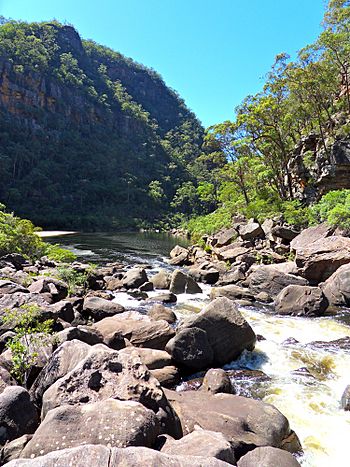Colo River facts for kids
Quick facts for kids Colo |
|
|---|---|

King Rapids on the Colo River in Wollemi National Park, 2010.
|
|
| Country | Australia |
| State | New South Wales |
| Region | Sydney Basin (IBRA), Central Tablelands, Blue Mountains |
| Municipalities | Lithgow, Hawkesbury |
| Physical characteristics | |
| Main source | Capertee River |
| 2nd source | Wolgan River |
| River mouth | confluence with the Hawkesbury River near Lower Portland 4 m (13 ft) 33°26′15″S 150°53′11″E / 33.437452°S 150.886294°E |
| Length | 86 km (53 mi) |
| Basin features | |
| River system | Hawkesbury-Nepean catchment |
| Tributaries |
|
| Bridges | unnamed (Putty Road |
| National parks | Blue Mountains NP, Wollemi NP |
The Colo River is a river in New South Wales, Australia. It is part of the larger Hawkesbury-Nepean river system. The river flows through the Central Tablelands region.
Contents
Where the River Flows
The Colo River starts in the Great Dividing Range. It is formed when two other rivers, the Wolgan River and the Capertee River, join together. This meeting point is northeast of Newnes. These two rivers drain the Wolgan and Capertee Valleys, which are north of Lithgow.
The Colo River first flows east, then turns south. It carves a deep gorge through the northern part of the Blue Mountains. Most of the river runs through Wollemi National Park. This middle part of the Colo River is wild and hard to reach. In the late 1970s, environmental groups helped protect this area from building and logging.
After leaving the wilderness, the lower part of the Colo River flows through a beautiful, narrow farming valley. It eventually joins the Hawkesbury River near Lower Portland. This is north of Windsor. Some smaller rivers and creeks that flow into the Colo River include the Wollangambe River and Wollemi Creek. The river drops about 214 meters (702 feet) along its 86-kilometer (53-mile) path.
At a place called Colo, the Putty Road (B84) crosses the river.
A Special Wilderness Area
The areas around the Colo River, including the Blue Mountains National Park and Wollemi National Park, are very special. They are part of a World Heritage Site. This is partly because of the discovery of the Wollemi Pine tree. This tree is often called a 'living fossil' because it has been around since the time of the dinosaurs!
The Colo River gorge has many rocky rapids and deep pools. Even though it's quite close to the big city of Sydney, the Colo River flows through the largest wilderness area in New South Wales. Local volunteer groups, like "Friends of the Colo," work to remove plants that don't belong there and protect the natural environment.
River History
The original owners of the land around the Colo River are the Australian Aboriginal people of the Darug nation. They have lived there for a very long time.
Europeans first explored the lower Colo River in June 1789. This was done by Governor Phillip. People started settling there in the early 1800s. More land was given out for settlement from 1833. Before cars were common, the Colo River was important for transport. Farmers used it to move their crops and goods down to the Hawkesbury River and then to Sydney.
Fun Activities
The Colo River is a great place for outdoor activities. Many people enjoy bushwalking (hiking) along its banks. Canoeing is also popular on the river's waters. Fishing is another favorite pastime. There are also places to stay, like accommodation retreats, along different parts of the river.
Images for kids
-
The Colo River under low-water conditions at Upper Colo.

